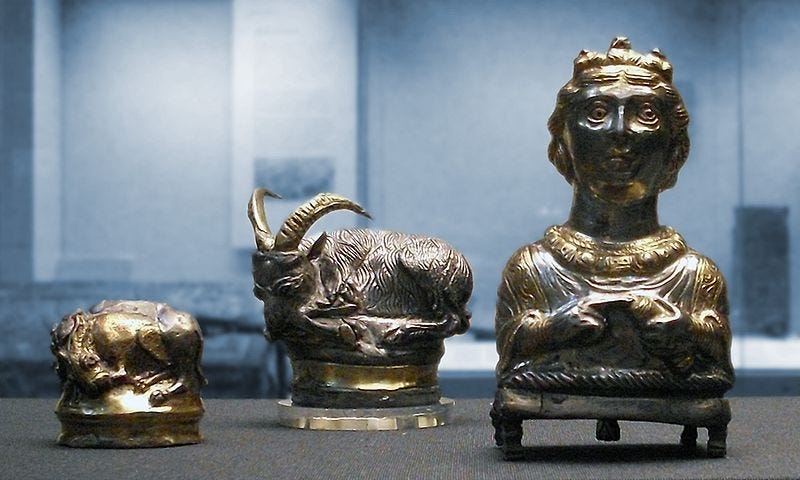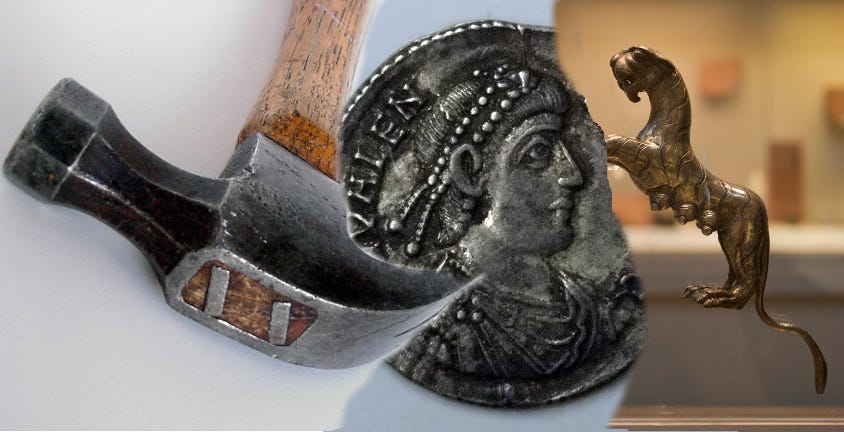Lost a hammer, found a treasure: the incredible story of the Hoxne Hoard.
A farmer's misplaced hammer led to the discovery of an incredible cache of Roman-era artifacts.
My last few articles have been awfully heavy and frankly depressing, and I just can’t write about climate change today. So here’s something a little lighter.
On this date 29 years ago, November 16, 1992, Peter Whatling, a tenant farmer in Suffolk, England, lost a hammer somewhere in his fields. Unable to find it with a cursory search—the grass was too tall—he asked his friend Eric Lawes, who owned a metal detector, to bring his machine out to the field to look for it. The metal detector buzzed over a particular plot of ground and it seemed like mission accomplished. But instead of finding Peter Whatling's hammer, they found a silver spoon that looked quite old. Digging further, the two men discovered some more curious items: pieces of gold jewelry and antique coins. Wondering if they had found something historically or archaeologically significant, they notified local authorities, who came out the next day and unearthed an incredible treasure.
What became known as the Hoxne Hoard—Hoxne's the village it was found in, and it's pronounced “Hoxon”—was a fabulous cache of treasure from the late Roman/early Byzantine era. There are 15,000 coins, about 100 spoons and ladles, 29 pieces of gold jewelry, silver vases, beakers and bowls, a pepper pot (forerunner of the pepper shaker) cast to resemble a stately woman, and, most curiously, a silver tigress emphasizing six prominent teats. The exact function of this object isn't entirely known, though it's suspected to be the handle of something. And yes, they did eventually find Peter Whatling's hammer.
Judging from metallurgical analysis and the dates of the coins, the treasure appears to have been buried in the early part of the 5th century A.D./C.E. This period coincides with the violent upheaval that was occurring in the British Isles as a result of the collapse of Roman authority. Several coins in the Hoxne Hoard are what we would call Byzantine, pertaining to what was then the eastern half of the Roman Empire (the western half would “fall” in 476). Some of the coins depict Constantine II, the son of Constantine the Great, who founded the Byzantine Empire and named its capital (formerly called Byzantium or Byzantion) after himself. The hoard was found inside the remains of an oak box and various items were arranged on top of each other, indicating that they were carefully packed inside this box before burial.

But who buried the treasure? And why? We can't ever know that. The social and economic system of post-Roman Britain was extremely complex. The owners of the treasure, perhaps a wealthy landowner and his wife—there are Roman names inscribed on some of the items—might have buried it to keep it out of the hands of brigands or thieves. Or thieves themselves might have buried it, after looting the stuff from a wealthy estate. It might have been buried to de-emphasize the owners' formerly Roman identity, though to me this sounds a bit of a stretch; they could have done that without economic loss by melting down the stuff and recasting it into other objects.
Clearly something unusual was going on in this part of England at that time. The Hoxne Hoard is not the only buried treasure from this era found in the area. In 1781 a lead box full of Roman coins was unearthed just 2 miles from where the Hoxne treasure was eventually found. Other similar hoards have been found in various parts of Britain, and some may remain undiscovered. What caused rich people to suddenly run around burying boxes of treasure all over the place? This is a fascinating historical mystery; perhaps archaeologists or historians will solve it someday. When I tell my middle school students about the Hoxne Hoard, they are invariably amazed.
The Hoxne Hoard is now one of the star collections in the British Museum, having been acquired in 1994. Peter Whatling's hammer is also officially part of the collection. No, really! It is!
The image of the Roman coin is by Wikimedia Commons user Fae, licensed/relicensed under GNU Free Documentation License. The photo of the tigress is by Mike Peel (www.mikepeel.com) and licensed/relicensed under Creative Commons 2.5 License.
☕ If you appreciate what I do, buy me a virtual coffee from time-to-time to support my work. I know it seems small, but it truly helps.
📖 You could also buy my book, which I wrote in part to take my mind off climate anxiety.
🎓 Like learning? Find out what courses I’m currently offering at my website.
📽 More the visual type? Here is my YouTube channel with tons of free history videos.
💌 Feedback to share or want to say hello? Hit reply on this email or leave me a comment on Substack.




